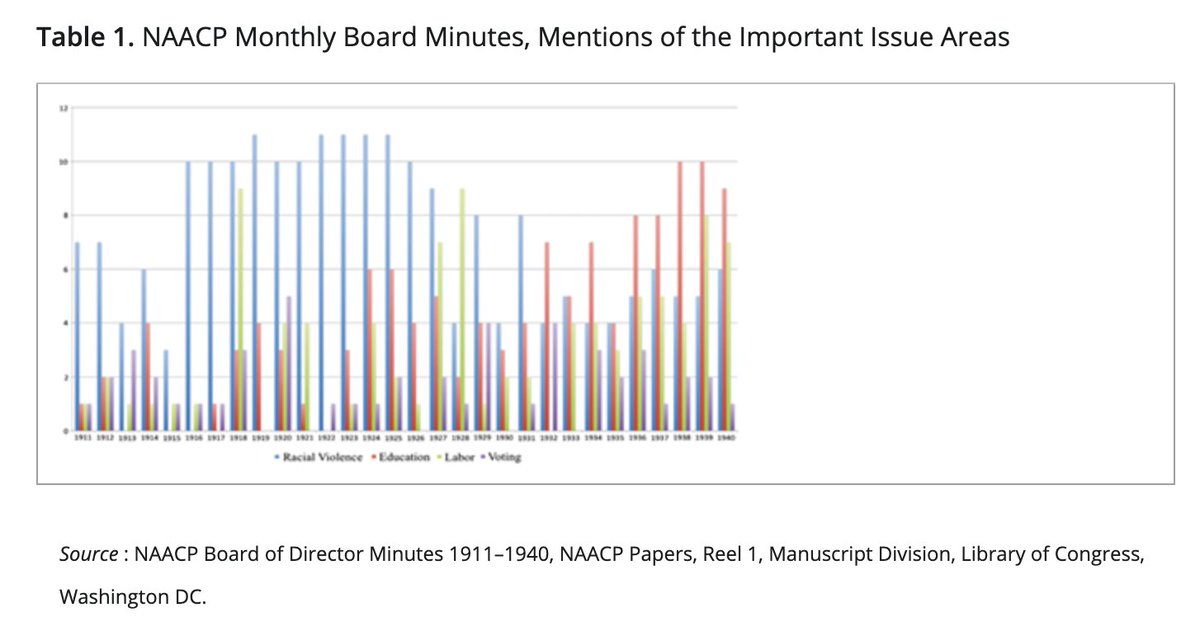1/ I have been learning from #Tweetablackeconomist but today I am going to tweet a political scientist, @MeganFrancis. Econs should spend more time studying philanthropy in general, but the role of philanthropy in reshaping racial justice movements in specific.
2/ This is a paper I am adding to my MBA syllabus. We give preferential tax treatment to nonprofits and foundations. Public policy is shaped by what we delegate to nonprofits.
Well, enter some fascinating work by @MeganFrancis.
Well, enter some fascinating work by @MeganFrancis.
3/ In her paper in the Law and Society Review, she examines the changing agenda of the NAACP. She provides evidence that in roughly the first quarter of the 20th century, the NAACP was laser-focused on ending lynching and violence against black people.
4/ Officers of the org articulated that addressing other issues such as housing or voting rights could only come after addressing the issue of racial violence.
Nonetheless, in the 1930s, the NAACP shifted its focus to education.
Nonetheless, in the 1930s, the NAACP shifted its focus to education.
5/ Those litigation efforts culminated in the landmark Supreme Court decision in Brown vs. Board of Education. But, Francis shows evidence that lynchings and not education were the primary focus of discussions in NAACP board meetings in the first quarter century.
6/ So what happened? Well, @MeganFrancis argues, and presents evidence that the NAACP& #39;s mission was "captured" during a period of financial weakness by its most important funder, the Garland Fund.
7/ The Garland Fund was formed in 1922 when Charles Garland refused his inheritance and decided to dedicate his fortune to supporting liberal causes.
8/ The almost exclusively white-led organization& #39;s initial mission was to provide money to movements supporting labor, education, and the advancement of minority groups.
9/ The NAACP was the only group devoted to minority rights to receive grants in 1922 and 1923 and received it for its anti-lynching work. However, the Garland Fund moved toward a more hands-on approach to funding and articulated labor and education as its major priorities.
10/ As most other foundations were unwilling to fund the NAACP, the NAACP, according to @MeganFrancis, acquiesed to the Fund& #39;s priorities.
@MeganFrancis notes, "Education, I have argued in this article, became the defining issue of civil rights law because whites at the…
@MeganFrancis notes, "Education, I have argued in this article, became the defining issue of civil rights law because whites at the…
11/ …Garland Fund believed it should be and not because the NAACP believed education represented a more viable doctrinal route available to black litigants."
12/ Clearly, this historical analysis has new resonance in our era and I am eager to discuss this work with the students in my nonprofit strategy class as the potential for funders to "capture" a movement is still present.
13/ I should note that there is a follow-up paper, that I will also assign, in which @MeganFrancis and @JohnFabianWitt discuss the extent to which the Garland Fund captured the NAACP vs the NAACP& #39;s influence on the Garland Fund.

 Read on Twitter
Read on Twitter



